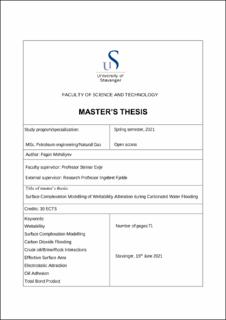| dc.description.abstract | Within the context of global warming, Carbon Dioxide (CO2) capture and its utilization in oil recovery are seen as one of the majority methods to decrease Greenhouse Gas (GHG) emissions over the next few decades. CO2 flooding is considered an Enhanced Oil Recovery (EOR) method and can increase the oil recovery factor up to 60%-70% by changing the wettability preference of the reservoir rock. The aim of this thesis is to estimate the wettability preferences of the individual minerals, reservoir rocks, and mineral mixtures during Formation Water (FW) and Carbonated Water (CW) injection. Moreover, the effects of temperature and pressure on the wettability of an individual mineral (calcite) were also studied to improve the understanding of the CO2 flooding impact on reservoir rock wettability.
The literature study of this M.Sc. thesis outlines how wettability affects the oil recovery, the impact of the oil composition, brine composition, and CO2 on the wetting state of the individual minerals and reservoir rock. Moreover, the simulation works were carried out to estimate the wettability preferences of the minerals, Sandstone Reservoir Rocks (SRR), and Pseudo-Sandstone Rock (PSR)/mineral mixtures. The simulation part was based on Surface Complexation Modeling (SCM) and presented a set of simulations in the geochemistry solver PHREEQ-C, run at various pressures and temperatures, in which wettability states were estimated. The wettability preferences were estimated by calculating bond products defined as the product of the mole fraction of oppositely charged oil and mineral surfaces.
During FW injection, SCM results showed that the quartz and albite were strongly hydrophilic while calcite was strongly hydrophobic. On the other hand, clay minerals (i.e., illite and montmorillonite) were less hydrophobic than calcite and more hydrophobic than quartz. In CW, the wettability of dominant (based on weight and surface area) minerals in SRR (i.e., quartz and calcite) was found to be altered toward less hydrophobic, while the opposite effect was noticed for clay minerals. For SRR, the SCM results revealed that their wettability preferences were hydrophilic in both FW and CW. Nonetheless, increasing the content of the hydrophilic minerals increases the rock’s tendency to become more hydrophilic.
The SCM results showed that the intrinsic properties of the minerals, such as surface area and surface charge, have an enormous impact on the reservoir rock wetting state. For PSR with low calcite content, the wettability was inclined towards the mineral with dominant surface area. As calcite is strong hydrophobic compared to the other studied minerals, increasing the calcite content altered the wettability of the rock toward less water-wet, even if clay minerals dominated the effective surface area. From the SCM results, the divalent cations bridging was the dominant oil adsorption mechanism for the main sandstone minerals. Nevertheless, direct adsorption of carboxylate was also estimated in clay minerals and calcite.
In this study, the temperature and pressure effect on the wettability alteration of the calcite was also investigated. However, SCM results at different temperatures and pressures show that these reservoir properties have a minor impact on the wetting state of calcite during FWI and CWI.
The SCM technique is a quick and economical method of estimating the wettability of the minerals and reservoir rocks. SCM can be used as the first screening tool to estimate the potential for CW effect on reservoir wettability. Then further evaluation of potential in laboratory experiments and reservoir simulations should be performed.
As a continuation of the simulation work performed in the present study, it is suggested to perform experiments with FW and CW using the USBM method to determine the wettability preferences of reservoir rocks at various pressures and temperatures. Since the SCM method and flotation tests have limitations in minerals distribution, SCM also has limitations with the effective surface area of minerals. On the other hand, in USBM experiments, mineral distribution can be taken into account. This is because the USBM method estimates the wettability of the bulk rock while the flotation test estimates the wettability of crushed rock. | |
